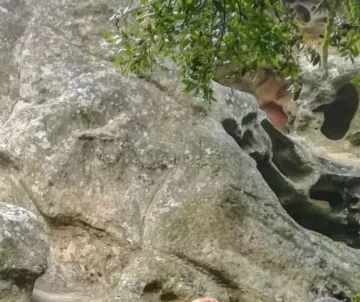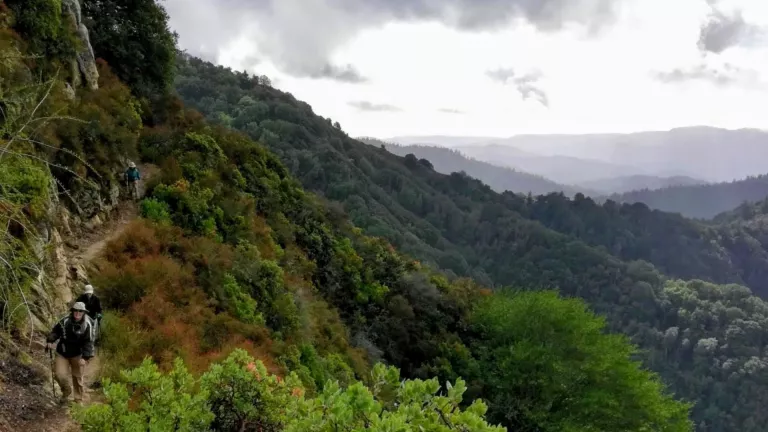
Dr. Russell Varian, a pioneer of x-ray and radar technology, spent much of his youth exploring and hiking the canyons near Castle Rock. Varian was the first to measure Earth’s magnetic field, using some sites in today’s park. In 1959, he secured an option to purchase this land and planned to donate it to California State Parks. Varian died before completing the purchase. The Sierra Club and Sempervirens Fund later donated the land in his memory. In July of 1968, Castle Rock was designated a state park.
Situated along the Santa Cruz Mountains in Los Gatos, just 20 minutes from San Jose, is Castle Rock State Park and it’s plethora of beautiful hikes. This park has trails for all levels and especially attracts rock climbers and nature lovers. Home to various types of flora this park is one of many places you can see the famous California Coastal Redwoods and giant fir trees. The trail system with views of canyons and rock formations are part of the open space that California is known for. You can enjoy horseback riding along certain trails as well.
History
The park is located among what once was home to many different tribal communities. Over thousands of years, the tribes of the region have come to be collectively recognized as the Ohlone people. Several areas in this location served their dietary and spiritual needs. Ohlone visionaries used the massive rocks to connect to their spiritual world and to acquire personal enlightenment. They also collected a wide variety of medicinal and food plants. Native people hunted deer, pronghorns, and bears that were attracted to the area’s abundant vegetation. Today’s park lies within a major trail system that was used to move resources from the coast into the interior.
By 1849, thousands of immigrants had arrived in California searching for gold. The newcomers needed lumber to construct homes and buildings for new towns, and coast redwood made excellent lumber, as well as tanoak bark that was used to tan leather goods. Once thick forests were quickly laid bare.
The Smead and Partridge farms were the largest operations on the ridge, with orchards of apples, pears, walnuts, and grapes. Near the park’s interpretive shelter, heritage trees planted in the early 1900s still bear fruit. Creation of the Park Judge Joseph Welch of Santa Clara Valley purchased a 60-acre parcel on Castle Rock Ridge in 1908, when logging was still ravaging the hillsides. He established a precedent by opening his land for the public to enjoy its scenic vistas and rugged landscapes. Castle Rock soon became a popular tourist destination.
Species
Wild animals and reptiles seen in the park include black-tailed deer, gray foxes, coyotes, California newts, mountain lions, and many species of snakes. Turkey vultures, red-tailed hawks, acorn woodpeckers, quail, and scrub jays may be spotted. Peregrine falcons may soar overhead.
Value as Water Supply
The river flowing through the park provides Castle Rock—one of many sandstone outcrops in the park, spawning habitat for steelhead. Steep trails lead to the unusual rock formations at Varian Peak, Goat Rock, Russell Point, and Castle Rock.
Geology
Castle Rock’s famed sandstone outcrops originated as submarine fan deposits on the continental shelf about 30 to 40 million years ago. These shelf deposits were then elevated and moved north by repeated violent movements along the tectonic plate boundaries now defined by the San Andreas Fault. All of the rocks west of the fault line are fundamentally different from the rocks on the east side. The uniquely sculpted, rounded rock outcrops along Castle Ridge have eroded to form pits, pockets, ribs, and ridges. Referred to as tafoni, these erosional patterns have endless variations.
Vegetation and Agriculture
Castle Rock State Park is recovering from years of agricultural use and logging that have caused significant vegetation changes. The park hosts diverse native and nonnative plant communities: mixed evergreen forest, black oak forest, chaparral, grasslands, and riparian woodland. Spring flowers are displayed: pink or purple Chinese houses, lilac slender phlox, deep blue sky lupine, pink farewell-tospring, and golden elegant madia all thrive on the hillsides. Virgin- and second-growth redwoods grow at an unusual elevation, above 2,500 feet along Saratoga Gap Trail. Their low water supply accounts for these dwarf redwood trees’ uncommonly short 40- to 100- foot heights.
Threats
Climate change affects all living things within the redwood forest. Experts fear that the area’s increase in average temperature and decrease in rain and thick summer fog will endanger redwoods and other plants and creatures that depend on the redwood environment.
Learn More
